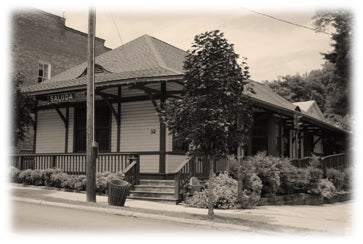Save the historic Saluda train depot
Published 10:00 pm Tuesday, March 3, 2015
A group of concerned citizens came together serendipitously to discuss the fate of Saluda’s Historic Depot, which is for sale. Out of this conversation grew a plan to “Save Saluda Depot” from commercial enterprises and turn it into a heritage museum and visitors center to honor and recognize Saluda’s origin and heritage.
“The Saluda Depot is a treasured historical landmark and should be owned by the citizens of Saluda,” says Cindy Stephenson Tuttle, chair of the Historic Saluda Committee.
To do this, requires raising funds to put an option on the depot and a plan on how to finance the purchase and make it a self-sustainable museum and visitors center. A fundraiser is planned for mid March to include a major donor campaign and a mailing to over 1,000 Saluda residents requesting participation at different levels so everyone can feel that they are playing a part in saving this Saluda landmark. The Saluda Downtown Foundation (SDF) has agreed to oversee this project so that grants can be requested through this organization using the SDF’s non-profit status.
History of Saluda and the railroad
When the first passenger train of the Asheville and Spartanburg Railroad chugged up the Saluda Grade on July 4, 1878, Pace’s Gap was forever changed. By February, 1881, the growth and prosperity of Pace’s Gap had escalated to the point that it was chartered as the town of Saluda, named for Saluda Mountain, which is actually not a mountain but a group of mountains with the Saluda River at its foot.
Though the Saluda Grade opened to rail traffic in 1878, the idea for tracks across the mountain came about as early as 1832, when the demand became great to move goods, livestock and humans up the mountain away from the stifling heat of the thermal belt of South Carolina and Georgia into the new settlements further west. When surveying began, it became apparent that the best route was the one taken by the early settlers to travel to the new lands. This trail traversed the rolling foothills of the Piedmont and continued up the steep grade into the Blue Ridge Mountains.
It wasn’t until 1877 that Capt. Charles Pearson, former Confederate Army officer, was assigned chief engineer. Pearson’s ultimate goal was to bring the line of the Asheville and Spartanburg Railroad across the Blue Ridge from Tryon to Asheville. This created quite a challenge since the early surveys revealed no route was available to ascend the mountains at a reasonable grade.
Rejecting the route along Howard’s Gap, the old trading path, due to the instability of the ground due to underground springs, Pearson selected a route which followed the Pacolet River up the steep gorge, an almost vertical wall. This route begins at the bottom of the Melrose Mountain at 1,081 feet and climbs to the town of Saluda cresting at an elevation of 2,097 feet.
In 1879, due to the depletion of financial resources and manual labor, the North Carolina legislature ratified a bill to provide financial support and to allow convicts to work on the construction of the line. The price paid by all workers, free or otherwise, was high, due to sickness and accidents resulting in a high death rate.
Despite this adversity, the tracks reached the top of the grade three months after the convicts began work on the project, resulting in the completion of the steepest mainline standard gauge railroad in the United States.
The Saluda Main Street Historic District is listed on the National Register of Historic Places, with the depot listed as a contributing structure. A description of the depot from that listing states the exact date of construction for the former Saluda Depot is not known, but it was likely built during the first decade of the twentieth century. Some local tradition claims that it replaced the earlier depot, which had been located on Main Street in the center of town, in 1910. The “new” depot was built about a quarter of a mile away, parallel to the north side of the tracks and west of the present U.S. 176 overpass.
In a town which owed its existence to the railroad and which depended on the railroad to transport its many summer dwellers and tourists in the late nineteenth and early twentieth centuries, the depot was one of the most important buildings in town. In 1983 the depot was moved to its present location in order to assure its preservation.
Although the depot is now positioned perpendicular to Main Street and the railroad tracks, it is architecturally very intact. It is a long rectangular structure defined primarily by its flared hipped roof with eyelid vents, widely overhanging braced eaves which cover the encircling platform walk, and stick style detailing. The combination passenger and freight station has German siding on the exterior, bay windows, six-over-six sash windows, and large freight doors as well as pedestrian doors. The well-preserved interior retains its unpainted vertical beaded board sheathing and paneling and some counters. In its new location, the depot has new chimneys, a new foundation, and an added railing around the outside.
When Southern Railroad discontinued use of the depot and it was falling into neglect, they sold the depot building to the City of Saluda for $1 with the condition that it would be moved from its original location west of town below the overpass. In 1983, The Eargle and Talbot families agreed to purchase the building from the city for $1,000 and move it to its current location on Main Street.
Another condition of the sale to the Eargle and Talbot families was to “restore” it to its authenticity and thanks to the Eargle family the depot is well-preserved. It has been used as retail space since 1985. “When agreeing to the sale of the depot, the city commissioners also asked that a space within the depot be reserved to display train memorabilia which has never been done with so many other priorities by the city. When the citizens of Saluda purchase the building and make it a museum, then this dream will finally be realized,” says Cindy.
The historic depot is a modern icon of Saluda’s beginning and subsequent prosperity with the coming of the train bringing passengers up the Saluda Grade, the steepest grade in the country. Because brave men built a railroad up a steep mountain, the small mountain village of Saluda is a thriving community with a historic downtown district with prospering shops and restaurants.
The town is surrounded by mountains and deep valleys in the Green River Gorge. These natural resources have drawn outdoor adventurists to bicycle, fish, zip line, kayak and hike mountain trails. These enthusiasts eat, stay, and shop in Saluda’s businesses. Every Saluda citizen, whether born here or those who got here as fast as they could, will be asked to support this project.
More information, details, and photos can be found at historicsaluda.org, Facebook, Twitter, and Youtube.
– Submitted by Cathy Jackson






